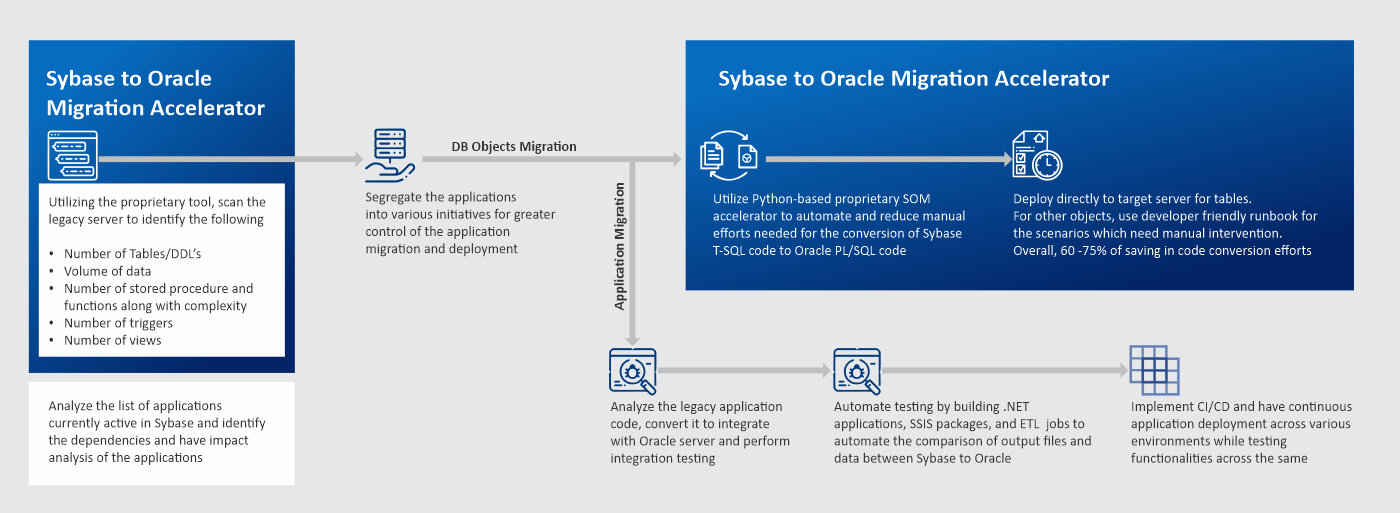Sybase, now SAP Adaptive Server Enterprise (ASE), and its related products have been a popular choice for enterprise database management systems. However, in the past few years, SAP’s investment in Sybase / ASE has slowed and diverted to HANA and its overall cloud strategy.
So what does this mean for businesses using SAP Sybase products? EoMM would mean no official or community support or new patches keep your Sybase products healthy and running seamlessly. Even if you do manage to get the necessary resources, it would have to come from third-party vendors, which would mean an increase in support costs every year.
Five Reasons Why You Should Migrate from Sybase Now
1. End of Mainstream Maintenance (EoMM) for ASE.
On November 29, 2018, SAP declared an EoMM for ASE 15.0.3, 15.5, 15.7, and 16.0. The date for ASE 15.x was 12/31/2020, and for ASE 16.x, it is 2/31/2025.
2. SAP has no real Sybase innovation to offer customers.
The last major release (16.0) of Sybase was in 2015. Although SAP released road maps for SAP ASE and SAP Replication Server in June 2019, neither show any plans for innovations around Sybase products, just incremental improvements of existing features. Instead, SAP has been steering its customers towards HANA, the cloud, or both – essentially, away from Sybase.
3. SAP has been ramping down its Sybase development and support teams.
SAP went through a significant restructuring in the spring of 2019, which resulted in over 4,000 employees being laid off. Experts have noted that this aligns perfectly with SAP’s cloud strategy, which has been to put SAP in a better position for new cloud investments by untying its Cloud Platform from Sybase and HANA database substructures.
4. Radio Silence on the Sybase Promotion Front
A key indicator of a company’s strategic commitment to a product line is the intensity of marketing efforts and the number of supporting resources it invests in a product line. There has been no evidence (whether through events or digital content) of any real efforts to promote or sustain SAP Sybase / ASE products since they shared the roadmap.
5. Public interest in Sybase discussions has waned.
Despite thousands of active Sybase deployments, there has been little-to-no new activity in Sybase user groups, forums, and communities, in the past few years, nor have there been any technical news or features on research sites.
75% of Businesses Using Sybase/ASE Are Migrating by 2025
A recent state-of-the-market survey of businesses (20000+) using Sybase/ASE facing the 2020 & 2025 EoMM deadline reveals that ~75% of them are planning to migrate from Sybase/ASE within the next five years, and almost 30% of those have decided to move to Oracle Database.
5 Things To Consider Before Database Migration
1. Business Impact
- Discovery/requirement gathering:
- Impacted teams, initiatives, and applications due to this migration
- Identifying the full scope and complexity is crucial for a successful
migration
- Impact on end-users – direct & indirect
- Impact on application performance
- Cut-over plan and downtime impact (if any)
2. Timeline
- Development, QA, UAT, Go-Live completion timelines for the migration
- Any deviation may lead to business impact and additional cost
3. Cost and Support
- Infrastructure & licensing cost
- Required environments with the right sized team to support the development effort
- Note: Manual migration further increases this cost due to large
development teams involved
- Note: Manual migration further increases this cost due to large
- Switching cost and support for the new database
4. Skillset & Training
- Consider existing teams’ current and required skillset and training needs
5. Migration Approach
Choosing the right process and tools is critical for quality and meeting the timelines, and avoiding any business impact
- Discovery: Complete knowledge of database and in-scope database objects
- Applications: Analyze all upstream and downstream applications related to the database
- Best Practices & Standards: Identify best practices and standards for the migration approach and target server
- Migration Options: Select the appropriate tools and approach considering business impact, complexity, cost, and effort. Migration can be done in two ways:
- Manual Migration of Database and related applications
- Automated Database Migration and manual migration of associated
applications
With manual migration, code re-writing is more prone to error, and the cost involved is very high. Automated database migration reduces the risks of human errors and reduces migration efforts by up to 50%.
Innova Solutions offers Sybase to Oracle Migrator Accelerator Solution for Automated Database Migration
Migration Process Flow With SOM
Application and Database Objects Migration Process Flow

Data Migration Process Flow

Innova Solutions’ SOM can handle the end-to-end migration process of DB code and data and offers a fast and cost-effective way to migrate all of your data from Sybase to Oracle while ensuring optimized utilization and a significantly reduced go-live timeline.


